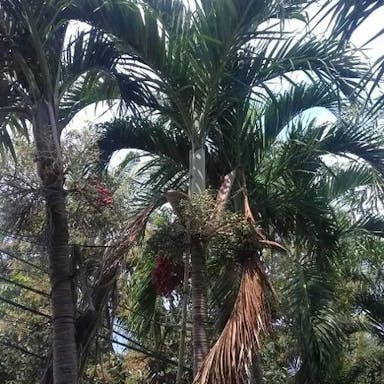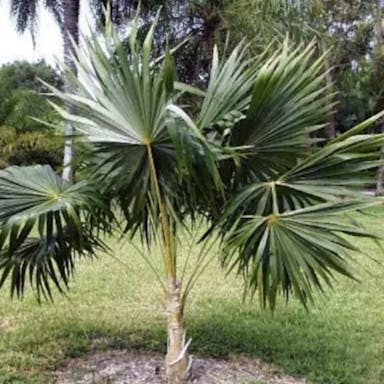Old man palm, scientifically known as Coccothrinax crinita, is a palm species native to Cuba. It is characterized by its slender trunk covered in old leaf bases, giving it a shaggy appearance. The leaves are fan-shaped, silver-green in color, and can grow up to 1.5 meters in length. The plant produces small creamy-white flowers that are clustered on long inflorescences. These flowers are followed by small black fruits that are attractive to birds. Coccothrinax crinita is a slow-growing palm that can reach heights of up to 10 meters. It is relatively easy to grow in tropical and subtropical climates, requiring well-draining soil and regular watering. This palm species is commonly used in landscaping for its ornamental value and can thrive in both full sun and partial shade. Its unique appearance and low maintenance make it a popular choice for gardens and parks.
Old man palm
- Scientific name
- Coccothrinax crinita
Basic Information
- Arecaceae Family Coccothrinax Genus Old man palm Species
- Arecaceae > Coccothrinax > Coccothrinax crinita
- 83%
- The Completeness of This Encyclopedia
Please help us complete the encyclopedia, Terrarium is a encyclopedia service to be completed with everyone in the world. Currently, this page is 83% complete. For more information on how to contribute, please click here.
- Palmae
- Tree
- Height
- 600cm ~ 1500cm
- Flower Color
- Leaf Color
- Anthesis
- Sunlight Exposure
Full Sun Long hours of sunlight from morning to afternoon Partial Shade A location in the shade of a tree or where either the morning or afternoon is shaded Full Shade A place where there is no direct sunlight
- Full Sun
- Hardiness Zones
This is an indicator to know to which zone each plant can winter. Knowing the zone of each plant gives you an idea of the cold temperature resistance when grown in the ground without a roof. 2: -42.7 to -40.0 3: -39.9 to -34.4 4: -34.3 to -28.9 5: -28.8 to -23.3 6: -23.2 to -17.8 7: -17.7 to -12.2 8: -12.1 to -6.7 9: -6.6 to -1.1 10: -1.0 to 4.4 11: 4.5 to 10.0
- 10-11
- Cold resistance
- Poor
- Heat resistance
- Excellent
- Habitat of origin
- Cuba
- Growth Rate
- Slow
What is Old man palm (Coccothrinax crinita)?
What is Old man palm (Coccothrinax crinita)
Flower meaning
The flower language commonly used in America for the Old man palm is: - Respect - Wisdom - Longevity One typical example is: - Respect: Old man palm flowers symbolize respect for elders and wisdom gained through experience. Birth flowers are specified by month and date only.
Calendar of Old man palm (Coccothrinax crinita)
Calendar
Old man palm typically blooms in the spring and summer months in the United States. The flowers are at their best during the warmer months when the plant receives ample sunlight and warmth. Blooming usually occurs once a year, lasting for several weeks. To encourage longer blooming periods, ensure the plant receives sufficient water, sunlight, and nutrients. Pruning dead or damaged fronds can also promote continuous blooming. Regular fertilization during the growing season can help sustain flower production.
How to grow Old man palm (Coccothrinax crinita)
Watering
Old man palm should be watered thoroughly when the top 1-2 inches of the soil are dry. During the growing season in spring and summer, water every 7-10 days. In fall and winter, reduce watering to every 2-3 weeks. Ensure proper drainage to prevent waterlogging, which can lead to root rot. Use room temperature water to avoid shocking the plant. Adjust watering frequency based on environmental conditions such as humidity and temperature. Monitor the plant for signs of overwatering or underwatering, such as yellowing leaves or wilting. Avoid letting the soil completely dry out between waterings to maintain optimal health.
Soil and Fertilizer
Old man palm thrives in well-draining soil with a slightly acidic to neutral pH level between 6.0 and 7.0. It prefers a soil mix rich in organic matter, such as peat moss or compost, to retain moisture without becoming waterlogged. Fertilize Old man palm with a balanced, slow-release fertilizer formulated for palms. Apply the fertilizer in early spring, summer, and early fall to promote healthy growth. Use a fertilizer with an N-P-K ratio of 8-2-12 or similar, following the manufacturer's instructions for the correct amount based on the size of the plant. Avoid over-fertilizing, as this can lead to nutrient imbalances and damage the plant. Regularly monitor the soil quality and adjust the fertilization schedule as needed to maintain optimal growth.
Sunlight and Place
Old man palm thrives in bright, indirect sunlight but can tolerate some direct sunlight. It has a high heat tolerance and can withstand temperatures up to 100°F (38°C). During winter, it should be placed in a spot with bright, indirect light to maintain its health. It can survive in temperatures as low as 50°F (10°C) but prefers temperatures above 60°F (15°C). Old man palm benefits from at least 4-6 hours of sunlight per day, making it ideal for placement near a window with eastern or western exposure. It should be protected from harsh midday sun to prevent leaf burn.
Advanced Information of Old man palm (Coccothrinax crinita)
Pruning
Old man palm requires pruning to remove dead or damaged fronds, promote new growth, and maintain its appearance. The best time to prune is in spring or early summer before the growing season. Pruning should be done using sharp, clean tools to make clean cuts without tearing the plant. Cut back fronds close to the trunk without damaging it. After pruning, apply a slow-release fertilizer to encourage healthy regrowth and water the plant adequately. Regular pruning helps prevent disease and pest infestations, ensuring the Old man palm remains healthy and vibrant.
Planting and Harvest
Old man palm is best suited for potted planting due to its slow growth and adaptability to container environments. When potting, choose a container with drainage holes to prevent waterlogging. Use well-draining soil mix rich in organic matter to promote healthy root growth. Place the plant in a location with bright, indirect sunlight and maintain a consistent watering schedule, allowing the top inch of soil to dry out between waterings. Repot the Old man palm every 2-3 years or when roots outgrow the container. During repotting, gently loosen the roots and place the plant in a slightly larger pot with fresh soil. Monitor for common issues like yellowing leaves or pest infestations, addressing them promptly to ensure the plant's health and vitality.
Propagation
Old man palm can be propagated through seeds, division, or offsets. Seeds should be sown in well-draining soil, kept moist, and placed in a warm, bright location. Division involves separating the plant into smaller sections with roots attached. Cuttings can be taken from the stem and rooted in a moist, well-draining medium. Leaf cuttings can also be used by taking a healthy leaf and placing it in soil to root. To ensure successful propagation, it is recommended to use a combination of methods to increase the chances of success.
Pests and Diseases
Old man palm is susceptible to common pests such as spider mites, mealybugs, and scale insects. These pests can cause damage by feeding on the plant's sap, leading to yellowing of leaves and stunted growth. Regularly inspecting the plant for signs of infestation and using insecticidal soap can help prevent these pests. In terms of diseases, Old man palm is prone to fungal infections like leaf spot and root rot. Leaf spot appears as dark spots on the leaves, while root rot causes the plant to wilt and decline. To prevent fungal diseases, avoid overwatering the plant and ensure good air circulation around the leaves. Proper sanitation practices, such as removing infected plant parts, can also help control the spread of diseases.
Habitat of Old man palm (Coccothrinax crinita)
Habitat
Toxicity of Old man palm (Coccothrinax crinita)
Health Benefits
- edible
- Inedible
- Toxic
- No toxicity
NO DATA
Toxic for dogs and cats
NO DATA










